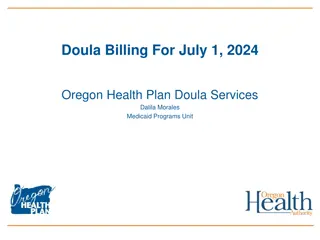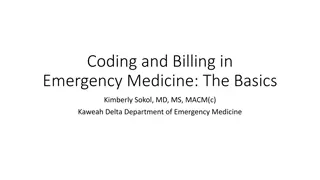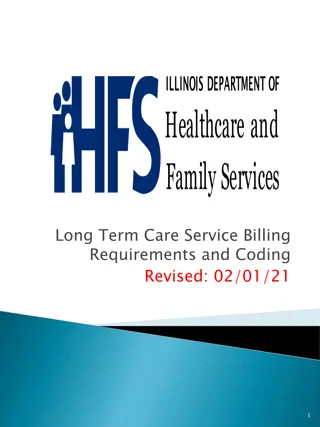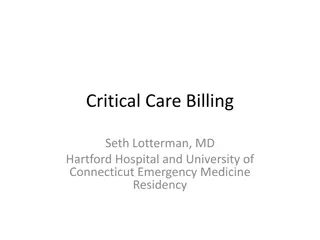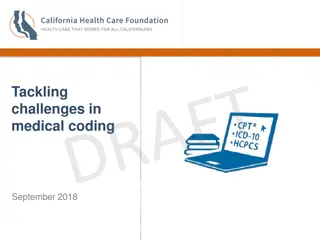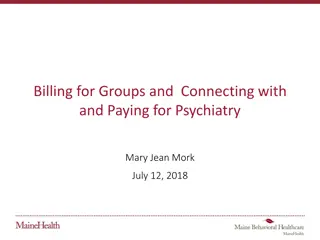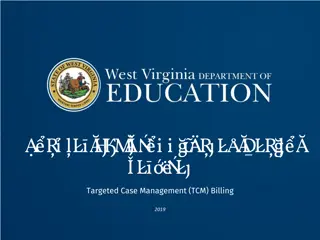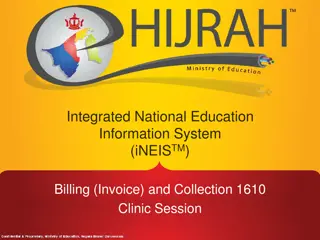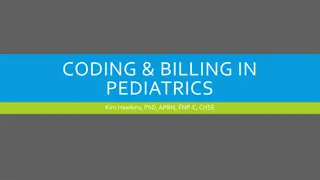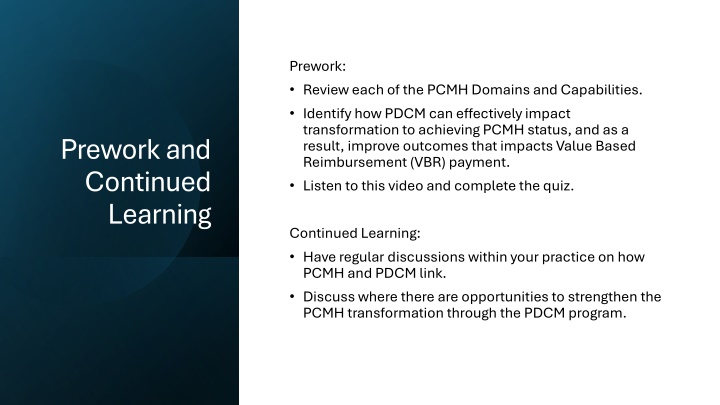
Impact of PDCM on PCM Healthcare Transformation
Explore how the Patient-Centered Medical Home (PCMH) model can be enhanced through the Patient Driven Care Management (PDCM) program to achieve better outcomes and influence Value-Based Reimbursement (VBR) payments. Learn about the evolution of PDCM, PCM capabilities, and the importance of sustainable funding for PCM transformation.
Download Presentation

Please find below an Image/Link to download the presentation.
The content on the website is provided AS IS for your information and personal use only. It may not be sold, licensed, or shared on other websites without obtaining consent from the author. If you encounter any issues during the download, it is possible that the publisher has removed the file from their server.
You are allowed to download the files provided on this website for personal or commercial use, subject to the condition that they are used lawfully. All files are the property of their respective owners.
The content on the website is provided AS IS for your information and personal use only. It may not be sold, licensed, or shared on other websites without obtaining consent from the author.
E N D
Presentation Transcript
Prework: Review each of the PCMH Domains and Capabilities. Identify how PDCM can effectively impact transformation to achieving PCMH status, and as a result, improve outcomes that impacts Value Based Reimbursement (VBR) payment. Listen to this video and complete the quiz. Prework and Continued Learning Continued Learning: Have regular discussions within your practice on how PCMH and PDCM link. Discuss where there are opportunities to strengthen the PCMH transformation through the PDCM program.
The Evolution of PDCM and Care Management Billing Codes Billing and Coding History
History BCBSM PGIP PCMH Program Development Development began in 2008 in collaboration with PGIP Physician Organizations (POs) Sustainable Funding to support MICMT through development of PDCM Billing Codes Fundamental to the PDCM program
The Patient-Centered Medical Home (PCMH) is a care delivery model in which patient treatment is coordinated through primary care physicians to ensure patients receive the necessary care when and where they need it, in a manner they can understand. The PCMH-Neighbor (PCMH-N) model enables specialists and sub- specialists, including behavioral health providers, to collaborate and coordinate with primary care physicians to create highly functioning systems of care. BCBSM The goals of the PCMH/PCMH-N model are to: Strengthen the role of the PCP in the delivery and coordination of health care. PCMH Model Support population health management, which uses a variety of individual, organizational and cultural interventions to help improve the illness and injury burden and the health care use of defined populations. Ensure effective communication, coordination and integration among all PCP and specialist practices, including appropriate flow of patient care information, and clear definitions of roles and responsibilities. BCBSM PGIP PCMH-N Interpretive Guidelines 2023-2024
2010 Multi- Payer Advanced Primary Care Practice Grant - MIPCT In the summer of 2010, Center for Health and RT staff led the writing and analytics of the State of Michigan s grant proposal for the Centers for Medicare and Medicaid Services (CMS) Multi-Payer Advanced Primary Care Practice Demonstration project. Michigan s project known as the Michigan Primary Care Transformation Demonstration Project (MiPCT) was a three- year, multi-payer, statewide demonstration project aimed at reforming primary care payment models and expanding the capabilities of the state s patient-centered medical homes. CMS extended project funding for two additional years through the end of 2016.
Reforming primary care payment models Sustainable funding to expand PCMH capabilities Establish a training program and payment model for provider delivered care managers Establish a means to offset the cost of care managers through billing codes PDCM A Framework for MIPCT CM Reimbursement Develop a framework of the care manager role and expectations as part of the PCMH Provider agreement Development of a patient-center plan of care Improved outcomes and decreased cost
The goal of Provider-Delivered Care Management is to provide: Patient education Care coordination Other support services The program is designed to help patients with chronic conditions address medical, behavioral, and psychosocial needs to ensure they are successful in meeting their health goals. How: Use of PDCM codes for either face-to-face (video) or telephonic encounters by health care teams working collaboratively with the patient and the patient s physician. PDCM Goal
dated_October_2018.pdf?rev=52079a3228ea48e98dd6c37cfabc71bc&hash=E718298B01C7644203819651C2DF654dated_October_2018.pdf?rev=52079a3228ea48e98dd6c37cfabc71bc&hash=E718298B01C7644203819651C2DF654 https://www.michigan.gov/mdhhs//media/Project/Websites/mdhhs/Folder3/Folder45/Folder2/Folder145/Folder1/Folder245/SIM_Summary_Up Focused on the development and testing of multi-payer health care payment and service delivery models to achieve: Better Care Coordination Lower Cost Improved Health Outcomes The primary outcome was technology awareness and developments for electronic transfer and transparency for care coordination amongst: Healthcare providers (specialist primary care hospital) Community services (food housing transportation) Behavioral health entities (inpatient outpatient providers) Admission Discharge Transfers from Acute Care to Primary Care SIM Overview Expansion of the care manager team, to include care coordinators Community Health Workers Primary Care Population Health Coordinators
PGIP PCMH MIPCT PDCM In Summary The Blue Cross Blue Shield of Michigan Patient-Centered Medical Home (PCMH) model is fundamental to the Provider-Delivered Care Management (PDCM) program. It is a funding source to help sustain care management that is delivered in the physician s office, provided by trained care team members in conjunction with the physician. The PDCM program ensures patients with chronic conditions receive effective and efficient care, leading to better outcomes and lower costs for patients.
In addition to the PDCM billing codes, organizations receive incentives for transforming from the Acute Care Model to the Chronic Care Model using the PCMH Domains and Capabilities. By advancing the transformative work, organizations receive incentives through Value-Based Reimbursement (VBR) payments. The 12 Domains outlined in the PCMH Interpretive Guidelines, along with the capabilities provide a description of the actions to meet the capabilities to aide the practice in transformation to the specified domain. PCMH Domains and Link to PDCM Funding for Quality Metrics Preventive care, Utilization, Chronic Condition Treat- to-Target When BCBSM began developing its PCMH program in 2008 in collaboration with PGIP Physician Organizations (POs), it became clear that practices could not wave a wand and turn into a fully realized PCMH overnight. The domains are intended to provide the infrastructure to guide the practices and ensure effective patient-centered care built on the evidence. Each domain and capability impacts the overall transformation.
1.0 PATIENT-PROVIDER PARTNERSHIP 2.0 PATIENT REGISTRY 3.0 PERFORMANCE REPORTING 4.0 INDIVIDUAL CARE MANAGEMENT 5.0 EXTENDED ACCESS 6.0 TEST RESULTS TRACKING & FOLLOW-UP 8.0 ELECTRONIC PRESCRIBING AND MANAGEMENT OF CONTROLLED SUBSTANCE PRESCRIPTIONS The Domains 9.0 PREVENTIVE SERVICES 10.0 LINKAGE TO COMMUNITY SERVICES 11.0 SELF-MANAGEMENT SUPPORT 12.0 PATIENT WEB PORTAL 13.0 COORDINATION OF CARE 14.0 SPECIALIST PRE-CONSULTATION AND REFERRAL PROCESS
Taking a look at a few of the Domains Patient Registry Preventive Services Performance Reporting Individual Care Management Connecting PCMH to PDCM
Goal: Enable providers to manage their patients both at the population level and at point of care through use of a comprehensive patient registry. A paper or electronic all-payer registry is being used to manage all established patients in the Practice Unit with: Diabetes Where does this fit with the PDCM program? The practice/organization would use a registry report to identify patients in the practice who are out-of-scope within the evidence- based quality metrics for the condition(s) they selected. We will use diabetes for this activity. With a diagnosis of diabetes, the fields of the report would include HEDIS measures: A1C, Eye Exam, Urine Protein, and Blood Pressure. 2.0 Patient Registry A care team member within the practice/organization regularly conducts the population level reporting. Based on the practice goals, identifies patients that are out-of-scope with the evidence-care guidelines. The care team member refers the patient to care management services. Which PDCM code would apply to completing the registry reporting activities? How does the referral to PDCM services assist the practice in meeting their quality metrics, which will apply to the VBR payment?
Goal: Actively screen, educate, and counsel patients on preventive care and health behaviors. Primary prevention program is in place that focuses on identifying and educating patients about personal health behaviors to reduce their risk of disease and injury Where does Preventive Services link to the PDCM Program? When a patient has complex needs warranting care management services, we are treating the whole person. While supporting the patient with services to problem- solve and resolve the identified challenge, the care team member would also address any gaps related to preventive care. Example: A nurse care manager is working with a patient with the diagnosis of diabetes. The patient s A1C has been elevated for over 6 months. The patient and care manager are partnering to addess education, social supports and behavioral challenges. The nurse care manager reviews the patients gaps in care and notes the patient is due for a wellness visit, mammogram, and colonoscopy. The nurse care manager takes the opportunity to address these preventive needs with the patient and includes them on the care plan. The patient is established with care management, there is a plan of care in place. The care manager outreaches to the patient to review the plan of care and reminds the patient she is due for the preventive services. Which PDCM code would apply to the telephone call? How does this support the team in practice transformation and obtaining the VBR goal, specific to the Preventive Services Domain? 9.0 Preventive Services
Goal: Generate all-patient/payer reports enabling POs and providers to monitor their population level performance over time, close gaps in care, and improve patient outcomes. Performance reports that allow tracking and comparison of results at a specific point in time across the population of patients are generated for: Diabetes (or, for specialists, relevant patient population selected for initial focus and not addressed in other 3.0 capabilities) 3.0 Performance Reporting In our case study, the care manager will identify the treat-to- target measures and apply those that are out-of-scope to the plan of care. Over time, the care manager will monitor the outcomes to determine the trends towards improvement. This will inform the care manager and provider on the impact of the care plan. What PDCM codes would apply to the monitoring of the outcomes? How does this activity support the care team in achieving the performance reporting VBR goals?
1. See PGIP PCMH N-Interpretive Guideline: 1. 4.0 Individual Care Management 2. 11.0 Self-management 3. 13.0 Care Coordination 4. 10.0 Community Linkages Prework Next Steps: 1. Identify how the capabilities fit into the PDCM role. 2. Identify where there would be potential for PDCM billing code use. 3. Be prepared to discuss your discoveries in the live training. Next Steps 2.

